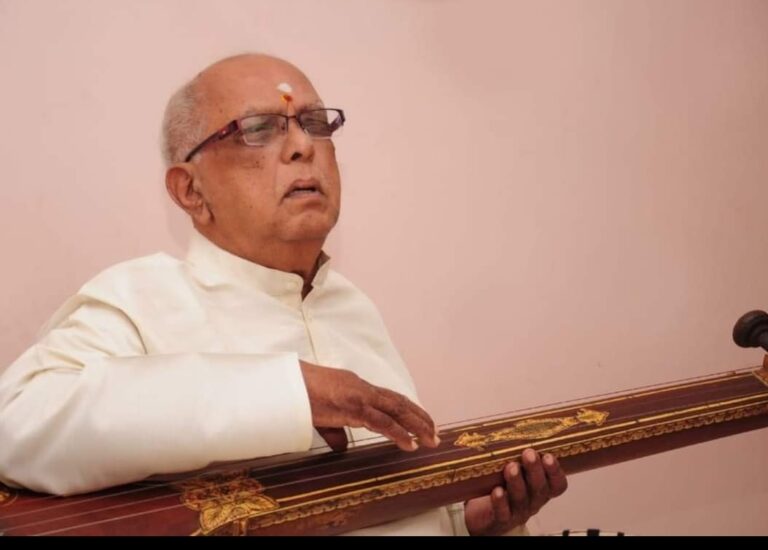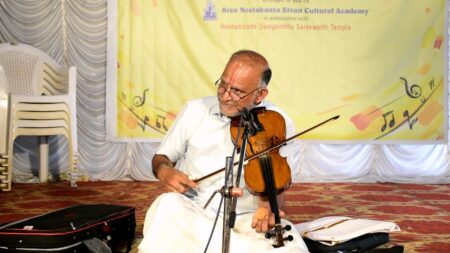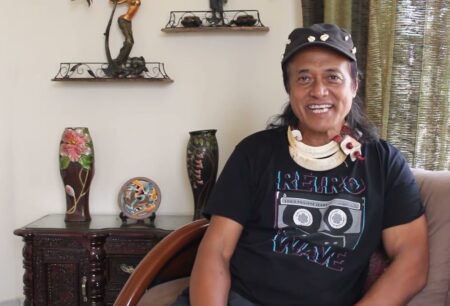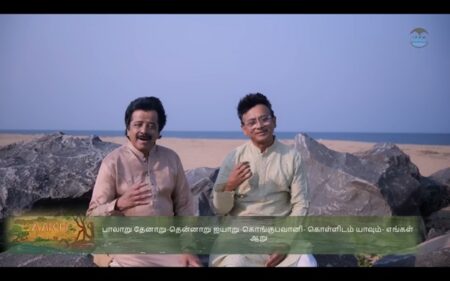Renowned carnatic musician Mangad Natesan passes away at 90, leaves legacy of musical excellence.
Mangad K Natesan, a revered Carnatic musician celebrated for his seamless blend of performance prowess and teaching finesse, passed away on Friday at the age of 90. Hailing from Kerala, Natesan distinguished himself among classical musicians for his ability to embody both performer and mentor roles with equal grace.
Born in Mangad (Kollam district), Natesan’s passion for music ignited early in life. His interest was sparked by the annual concerts held at the nearby Sree Kumarapuram temple. These concerts, featuring Nagaswaram recitals and Harikatha by renowned exponents, attracted music enthusiasts from distant places. Natesan, keenly attentive, engaged in elaborate discussions on the performances, nurturing an insatiable urge for music. His passion deepened through exposure to the gramophone records of M S Subhalakshmi, Musiri Subramania Iyer, Chembai Vaidynatha Iyer, and Ariyakudy.
Later, he was enrolled at the Swati Tirunnal Music Academy for Ganabhushanam. Natesan was groomed by a galaxy of supremos at the academy with Semmangudi at the helm in the capacity of the principal of the Academy. They included C S Krishna Iyer, K S Narayana Swamy, K R Kumaraswamy, M G Seetharama Iyer, and Hariharan. He had mentioned that it was their combined effort that had molded the musician in him. Further, each of them held the other in high esteem.
A musician rooted in tradition
Semmangudi advised us to follow Krishna Iyer closely whose full-throated singing will inspire you, Mangad Natesan said once. He had said that this team was instrumental in the renaissance of Carnatic music in Kerala. Maestros like Vina Sambasiva Iyer, Ariyakudy Ramanujam Iyengar, M S Subhalakshmi, T Brinda, and T Muktha were roped in to the Academy. The students benefited considerably from the live concerts of these icons of Carnatic music. Overawed by the presence of these stalwarts, music buffs in Thiruvananthapuram used to wonder, “Has Cauvery started flowing into Kerala?”
Post Ganabhushanam from the Academy, Natesan longed for Gurukula learning, which he considered the most ideal mode of education for all art forms of Indian origin. But times had changed; the only option was hard work that lasted for several years. B Grade and B High from AIR soon followed before he joined the Thrissur Station of All India Radio in 1975 as a staff artist.
Mangad Natesan’s services to the Station were exemplary in terms of the innumerable concerts in the annual program of Radio Sangeetha Sammelan. This further catapulted him to the center stage of classical music at the national level. A Top grade followed. Encomiums chased him even from Madras Music Academy, the fountainhead of Carnatic music. The title of Sangeetha Kala Acharya was conferred on him by the Academy, apart from Akademi awards and fellowships.
Music lessons on radio
Radio listeners across the State still cherish the memory of Mangad Natesan’s lessons aired through ‘Sangeetha Padham’ (Music lessons), beneficiaries of which have been legion. In this respect, his role as a guru is unparalleled. A cross-section of the outstanding performers and teachers of music today are his disciples. A stickler for tradition, Natesan was endowed with a rich repertoire, and his concerts are marked by inimitable creativity. Natesan’s concerts, characterized by poise and elegance of classicism, have proved that he is a traditionalist to the core.
At the same time, his classes were eloquent demonstrations of his meticulous care in grooming the young, many of whom have won wide acclaim as outstanding musicians over the years. Among his students Mukhathala Sivaji was the first to graduate into a consummate musician. Others include Muralidharan Unni, V R Dileepkumar, M S Parameswaran. Those who have opted for light music are G Venugopal, Lathika, Gayatri, Jyotsana, Asha G Menon and Alphonse. His daughter Dr N Mini is Professor and Head of the Department, Kannur University and his other daughters Priyadarshini and Meera pursue music teaching.





1 Comment
Truly a Sangeetha Kala Acharya.